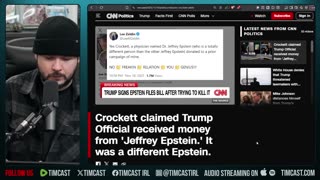Premium Only Content

What have archaeologists found about Jesus?
What have archaeologists found about Jesus?
Archaeologists have not found direct physical evidence of Jesus himself—such as his body, personal belongings, or writings—but they have uncovered a great deal of material that provides important context for understanding the historical Jesus and the world in which he lived. Here are the main categories of archaeological discoveries related to Jesus:
1. Historical and Geographical Confirmation
Many sites and artifacts confirm details mentioned in the New Testament, supporting the historical plausibility of the Gospels.
Nazareth: Archaeological digs have confirmed that Nazareth was a small, rural village in the 1st century, aligning with Gospel accounts of Jesus' upbringing.
Capernaum: Remains of a synagogue and houses dating to Jesus' time have been found here. This town was a base of Jesus' ministry.
Sea of Galilee towns: Places like Bethsaida and Magdala (home of Mary Magdalene) have yielded Roman-era buildings, roads, and coins.
Jerusalem: Extensive excavations have confirmed the layout of Herod’s Temple, the Pool of Bethesda, and the Pool of Siloam—places where Jesus is described as performing miracles.
2. Artifacts Related to Key Figures in Jesus' Life
Artifacts and inscriptions confirm the existence of people Jesus interacted with:
Pontius Pilate Inscription: A stone discovered in Caesarea Maritima bears the name of Pontius Pilate, confirming his role as Roman governor of Judea.
Caiaphas Ossuary: A richly decorated bone box (ossuary) found in Jerusalem is inscribed with the name "Joseph, son of Caiaphas," the high priest who, according to the Gospels, presided over Jesus' trial.
James Ossuary (disputed): A bone box inscribed "James, son of Joseph, brother of Jesus" was discovered, but its authenticity remains debated due to concerns about forgery.
3. First-Century Synagogues
Excavations of synagogues from the 1st century in Galilee, such as in Magdala, help confirm the setting where Jesus may have preached and read scriptures.
4. Crucifixion Evidence
No crucifixion artifacts tied directly to Jesus exist, but evidence shows how Romans carried out crucifixions:
Yehohanan's Skeleton: A man named Yehohanan was crucified in the 1st century. His heel bone was found with a nail still embedded, offering insight into Roman crucifixion practices.
5. Dead Sea Scrolls and Contemporary Texts
While not mentioning Jesus, these ancient Jewish texts found at Qumran give insight into the religious and political environment of the time, such as messianic expectations and tensions with Rome.
Summary:
Archaeology hasn't proven Jesus existed in a scientific sense, but it supports the historical reliability of the places, people, and customs mentioned in the Gospels. It affirms that the New Testament reflects a real world consistent with 1st-century Judea.
Would you like info on ongoing excavations or recent discoveries related to this topic?
-
 LIVE
LIVE
SpartakusLIVE
28 minutes agoTeam BUNGULATORS || From HUGE WZ DUBS to TOXIC ARC BETRAYALS
4,876 watching -
 37:06
37:06
Camhigby
34 minutes agoI Was Stalked By DRONE At Dearborn MOSQUE
-
 12:38
12:38
Timcast
21 hours agoJasmine Crocket HUMILIATED By CNN To HER FACE Over Epstein LIE | Tim Pool
31.7K62 -
 19:32
19:32
MetatronHistory
18 hours agoWas Nazism Left Wing or Right Wing? An Answer From History
44013 -
 LIVE
LIVE
a12cat34dog
2 hours agoI'M FINALLY BACK :: Resident Evil 4 (2023) :: FINISHING MAIN GAME & DLC {18+}
215 watching -
 31:23
31:23
Stephen Gardner
1 hour agoFINALLY! Charlie Kirk MISSING DETAILS released!
2.76K32 -

cosmicvandenim
6 hours agoCOSMIC VAN DENIM | SEX APPEAL & HORROR
4622 -
 LIVE
LIVE
DoldrumDan
2 hours agoFINISHING SEKIRO - DEPTH 5 TOP RANKED - DAY 50 NEW LIFE
44 watching -
 23:40
23:40
MYLUNCHBREAK CHANNEL PAGE
1 day agoWe Want the Blueprints
45.5K13 -
 LIVE
LIVE
PenguinSteve
3 hours agoLIVE! Penguin to the Battlefield (6)
78 watching